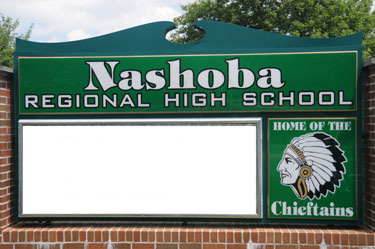
By Ann Needle
Looking for broader community input into priorities for the Nashoba schools, Superintendent Michael Wood devoted last night’s School Committee meeting to a public forum for setting some goals for next year’s District Improvement Plan.
The plan is a legally required document, updated each year, that outlines a district’s overall goals, along with ways these targets should be reached and success measured. As Committee Chair Nancy Federspiel of Bolton explained, “The District Improvement Plan is intended to be a living, working document, intended to look at the next 5 years in our district.” She also pointed out that it is these goals that perhaps make the biggest impact on the district budget.
For this school year, the plan was approved at the December 18 Committee meeting. However, this came after several drafts throughout the fall. Approval came with questions still remaining. Given copies of Nashoba’s 2012/13 plan, as well as the plans for each district school, about 30 Committee, staff, and community members spent the evening discussing priorities for next year’s plan and for future years.
After the Committee and participants were broken up into focus groups, several main goals appeared to surface.
School security was a major goal, though participants viewed “security” differently. Nashoba Director of Facilities Bill Cleary noted that more video cameras and key cards for the schools likely will be proposed in his department’s 2013/14 budget. These also are standout items in Nashoba Regional High School’s upcoming proposed budget, given both the Sandy Hook tragedy and thefts at the high school, according to NRHS Principal Dr. Parry Graham. He mentioned that he has been talking with the Bolton Police about putting a potential part-time policeman at the high school.
Center School First Grade Teacher Karen Mayotte also voiced a need for experts across the community — from first responders to psychologists — to aid in shoring up security.
Bolton Rep. Reta Rupich was one of those who asked if there should be a second look at the district’s school choice program. This allows students outside of the Nashoba District to attend school here, or for Nashoba students to go elsewhere. The district that the student leaves must pay the incoming district $5,000 per student. With a number of students flowing into Nashoba, this makes the choice program a significant revenue source, maintained Assistant Superintendent and Hale Middle School Principal George King. “If the kids went away, the revenue would go away,” he remarked.
“Most people don’t understand what a revenue source it is,” Rupich agreed. “They only see the downside, such as the longer pick-up line at school. And you put that together with a rising tax rate, and services seem to be going down.”
Better Evaluations, Communication
Getting Nashoba to effectively communicate with both its own community and district towns was another priority. Bill Cleary observed, “When we had community forums for the new turf field, only a handful of people showed up. We needed to let people know the importance of these things.”
Lancaster parent Paula Castner asked why the district could not better communicate Nashoba students’ achievements off of the sports fields.
Even when it comes to how taxes are spent on high-ticket items such as the turf field, Rupich remarked, “We should be giving better feedback on the money people have given us.”
With teacher evaluations being revised in the next few years, several staff members spoke vividly of the evaluation tools they would like to see utilized.
Parry Graham lauded feedback he has received about teachers from their students, noting, “Students are pretty good about knowing what good teaching looks like.” NRHS teacher Mary Marotta recalled having teachers visit each other’s classrooms last year to provide peer feedback, which sometimes offered other insights as well. “There was someone who had that ah-ha moment where they said, ‘I thought that that kid acted that way only in my class,’” she laughed.
Developing the use of technology in the schools also was a common theme for many, though interpretations of what this means varied widely. George King offered that the district could have a better online presence in some areas, while Graham noted that his interpretation of this would be to put networks such as Twitter to better use.
Superintendent Michael Wood said he would gather group responses to distribute to the Committee.